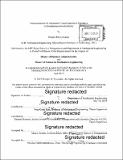| dc.contributor.advisor | Sang-Gook Kim. | en_US |
| dc.contributor.author | Nyovanie, Prosper M.(Prosper Munaishe) | en_US |
| dc.contributor.other | Massachusetts Institute of Technology. Department of Mechanical Engineering. | en_US |
| dc.contributor.other | Sloan School of Management. | en_US |
| dc.contributor.other | Leaders for Global Operations Program. | en_US |
| dc.date.accessioned | 2020-01-23T17:02:08Z | |
| dc.date.available | 2020-01-23T17:02:08Z | |
| dc.date.copyright | 2019 | en_US |
| dc.date.issued | 2019 | en_US |
| dc.identifier.uri | https://hdl.handle.net/1721.1/123640 | |
| dc.description | Thesis: S.M., Massachusetts Institute of Technology, Department of Mechanical Engineering, in conjunction with the Leaders for Global Operations Program at MIT, 2019 | en_US |
| dc.description | Thesis: M.B.A., Massachusetts Institute of Technology, Sloan School of Management, in conjunction with the Leaders for Global Operations Program at MIT, 2019 | en_US |
| dc.description | Cataloged from PDF version of thesis. | en_US |
| dc.description | Includes bibliographical references (pages 73-74). | en_US |
| dc.description.abstract | Currently, manual visual inspection is the gold standard for the required visual inspection of particulate matter in parenteral medicines. Automated visual inspection machines offer an opportunity for Amgen to improve efficiency, rate and consistency, while reducing its equipment footprint. However, the implementation of automated visual inspection poses challenges that need to be resolved. This thesis identified and developed solutions to three execution pain points: (1) low detection rates of dense particles in products; (2) misuse of automated inspection machines for product impact testing; and (3) ambiguous understanding of cost drivers when selecting an inspection method. The pain points mentioned above were addressed separately. First, experiments with modified plunger surfaces were conducted to determine their effectiveness at agitating dense particles into solution where the particles could then be easily detected. | en_US |
| dc.description.abstract | Second, embedded sensors were identified as the sensor of choice to measure the mechanical stress history of products passing through an automated visual inspection machine. Experiments were designed to test the effectiveness of accelerometers to replace the limited range of gyroscopes' rotational velocity measurements. Third, a cost benefit analysis model was created that used discounted cash flows to calculate the net present cost of selecting automated visual inspection or manual visual inspection. The results of these three work streams were promising. First, the experiments with modified plunger surfaces showed up to a 97% success rate of agitating particles into solution compared to an 1% success rate for the original plunger design. Second, experiments on accelerometers in embedded sensors showed that the accelerometers could measure centripetal acceleration that related to rotational velocity. | en_US |
| dc.description.abstract | A linear regression model was developed to relate accelerometer readings to rotational velocity within an accuracy of 50 RPM. Lastly, the cost benefit analysis model confirmed expected drivers regarding the favorability of different inspection methods. The model also showed that automated visual inspection is the cheaper method of inspection, even with conservative estimates of cost of capital and false eject rates. A follow-up effort is necessary to achieve a more streamlined implementation of automated visual inspection machines throughout Amgen's manufacturing network. | en_US |
| dc.description.statementofresponsibility | by Prosper M. Nyovanie. | en_US |
| dc.format.extent | 74 pages | en_US |
| dc.language.iso | eng | en_US |
| dc.publisher | Massachusetts Institute of Technology | en_US |
| dc.rights | MIT theses are protected by copyright. They may be viewed, downloaded, or printed from this source but further reproduction or distribution in any format is prohibited without written permission. | en_US |
| dc.rights.uri | http://dspace.mit.edu/handle/1721.1/7582 | en_US |
| dc.subject | Mechanical Engineering. | en_US |
| dc.subject | Sloan School of Management. | en_US |
| dc.subject | Leaders for Global Operations Program. | en_US |
| dc.title | Implementation of automated visual inspection machines in biopharmaceutical industry | en_US |
| dc.type | Thesis | en_US |
| dc.description.degree | S.M. | en_US |
| dc.description.degree | M.B.A. | en_US |
| dc.contributor.department | Massachusetts Institute of Technology. Department of Mechanical Engineering | en_US |
| dc.contributor.department | Sloan School of Management | en_US |
| dc.contributor.department | Leaders for Global Operations Program | en_US |
| dc.identifier.oclc | 1136610879 | en_US |
| dc.description.collection | S.M. Massachusetts Institute of Technology, Department of Mechanical Engineering | en_US |
| dc.description.collection | M.B.A. Massachusetts Institute of Technology, Sloan School of Management | en_US |
| dspace.imported | 2020-01-23T17:02:07Z | en_US |
| mit.thesis.degree | Master | en_US |
| mit.thesis.department | MechE | en_US |
| mit.thesis.department | Sloan | en_US |
